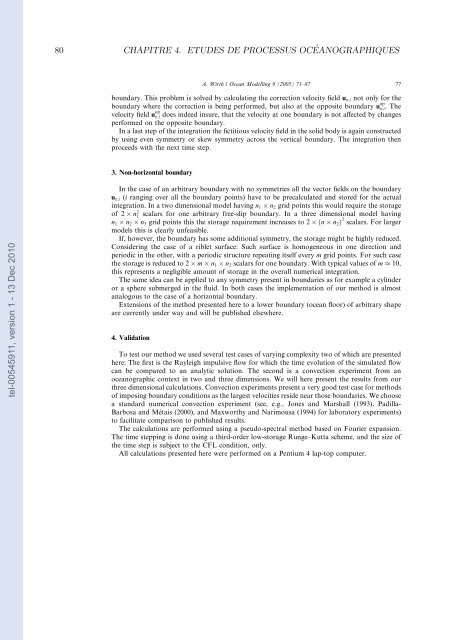Etudes et évaluation de processus océaniques par des hiérarchies ...
Etudes et évaluation de processus océaniques par des hiérarchies ...
Etudes et évaluation de processus océaniques par des hiérarchies ...
You also want an ePaper? Increase the reach of your titles
YUMPU automatically turns print PDFs into web optimized ePapers that Google loves.
80 CHAPITRE 4. ETUDES DE PROCESSUS OCÉANOGRAPHIQUES<br />
A. Wirth / Ocean Mo<strong>de</strong>lling 9 (2005) 71–87 77<br />
boundary. This problem is solved by calculating the correction velocity field u p;i not only for the<br />
boundary where the correction is being performed, but also at the opposite boundary u op<br />
p;i. The<br />
velocity field u op<br />
p;i does in<strong>de</strong>ed insure, that the velocity at one boundary is not affected by changes<br />
performed on the opposite boundary.<br />
In a last step of the integration the fictitious velocity field in the solid body is again constructed<br />
by using even symm<strong>et</strong>ry or skew symm<strong>et</strong>ry across the vertical boundary. The integration then<br />
proceeds with the next time step.<br />
3. Non-horizontal boundary<br />
tel-00545911, version 1 - 13 Dec 2010<br />
In the case of an arbitrary boundary with no symm<strong>et</strong>ries all the vector fields on the boundary<br />
u p;i (i ranging over all the boundary points) have to be precalculated and stored for the actual<br />
integration. In a two dimensional mo<strong>de</strong>l having n 1 n 2 grid points this would require the storage<br />
of 2 n 2 1<br />
scalars for one arbitrary free-slip boundary. In a three dimensional mo<strong>de</strong>l having<br />
n 1 n 2 n 3 grid points this the storage requirement increases to 2 ðn n 2 Þ 2 scalars. For larger<br />
mo<strong>de</strong>ls this is clearly unfeasible.<br />
If, however, the boundary has some additional symm<strong>et</strong>ry, the storage might be highly reduced.<br />
Consi<strong>de</strong>ring the case of a ribl<strong>et</strong> surface: Such surface is homogeneous in one direction and<br />
periodic in the other, with a periodic structure repeating itself every m grid points. For such case<br />
the storage is reduced to 2 m n 1 n 2 scalars for one boundary. With typical values of m 10,<br />
this represents a negligible amount of storage in the overall numerical integration.<br />
The same i<strong>de</strong>a can be applied to any symm<strong>et</strong>ry present in boundaries as for example a cylin<strong>de</strong>r<br />
or a sphere submerged in the fluid. In both cases the implementation of our m<strong>et</strong>hod is almost<br />
analogous to the case of a horizontal boundary.<br />
Extensions of the m<strong>et</strong>hod presented here to a lower boundary (ocean floor) of arbitrary shape<br />
are currently un<strong>de</strong>r way and will be published elsewhere.<br />
4. Validation<br />
To test our m<strong>et</strong>hod we used several test cases of varying complexity two of which are presented<br />
here: The first is the Rayleigh impulsive flow for which the time evolution of the simulated flow<br />
can be com<strong>par</strong>ed to an analytic solution. The second is a convection experiment from an<br />
oceanographic context in two and three dimensions. We will here present the results from our<br />
three dimensional calculations. Convection experiments present a very good test case for m<strong>et</strong>hods<br />
of imposing boundary conditions as the largest velocities resi<strong>de</strong> near those boundaries. We choose<br />
a standard numerical convection experiment (see, e.g., Jones and Marshall (1993), Padilla-<br />
Barbosa and M<strong>et</strong>ais (2000), and Maxworthy and Narimousa (1994) for laboratory experiments)<br />
to facilitate com<strong>par</strong>ison to published results.<br />
The calculations are performed using a pseudo-spectral m<strong>et</strong>hod based on Fourier expansion.<br />
The time stepping is done using a third-or<strong>de</strong>r low-storage Runge–Kutta scheme, and the size of<br />
the time step is subject to the CFL condition, only.<br />
All calculations presented here were performed on a Pentium 4 lap-top computer.
















